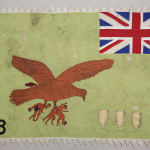 Asafo militia’s company flag, frankaa
Asafo militia’s company flag, frankaa
 Asafo militia’s company flag, frankaa
Asafo militia’s company flag, frankaa
Anonymous Fante artist (Ghana)
33 7/100 x 52 18/50 in
This captivating flag presents a classic Asafo proverb: “Will you fly off, or will you vanish?”. In other words, there is no way for an enemy or rival to escape. The magnificent eagle represents the Asafo company that owned this flag, while the men captured in its claws refer to what would happen to the members of a rival company if they would challenge them. This flag thus shows the symbolic battle between rival companies. The three white gong-gongs (dawur) are a symbol for the Asafo company’s attentiveness and alertness. Such gongs were important regalia of every company. Short messages could be transmitted with the three differently tuned gongs, and they were also used to accentuate and rhythmise the company’s songs. The gong-gong was the instrument used to alert the Asafo company to gather at the posuban shrine in case of an attack. The small object on the back of the eagle could represent a stylized canon. Several flags with eagles holding cannons are known, and the iconography was probably borrowed from the traditional English heraldic traditions. The Italian expert Federico Carmignani has attributed this captivating flag to the Kwamina Amoku workshop from the Anamabo village. The flags of this workshop often featured a single strong motive in the center placed on a plain background. The iconography is more naturalistic than the average Asafo flag, the feathers of the eagle detailed with black ink. The captured victims have detailed hairdos and wear short pants. Typically the flag doesn’t have a frame around the border. While the patina of the flag shows it was clearly exposed to the elements for an extended period of time, the more pristine condition of the Union Jack suggests it was replaced or remade later.
Provenance
Duncan Clarke, London, UK
Collection Jeffrey B. Spurr, Cambridge, US, -2020
let's keep in touch
Join our community & never miss out on a DUENDE moment from now on
* denotes required fields
We will process the personal data you have supplied to communicate with you in accordance with our Privacy Policy. You can unsubscribe or change your preferences at any time by clicking the link in our emails.

